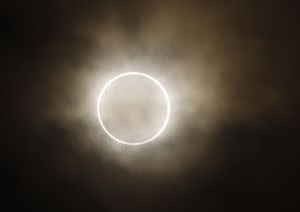‘Ring of Fire’ solar eclipse to be visible soon. Here’s how to see it, and when it’ll be in the sky

An annular solar eclipse will light up, or rather dim, the sky across the United States on Saturday.
The eclipse’s path will cross North, Central, and South America on Oct. 14, according to the U.S. National Aeronautic and Space Administration.
Known as the Ring of Fire, the celestial event will start off the Western Coast in Oregon, before traveling south and east through Texas and into Mexico and South America.
Time-wise, Atlanta area viewers are likely to see the eclipse starting around noon on Saturday, visible for between two to five minutes.
[DOWNLOAD: Free WSB-TV News app for alerts as news breaks]
The Ring of Fire is what’s known as an Annular Eclipse, which NASA said that means the sun will be visible as a bright ring around the moon. During this event, the moon will look small, only covering about 90% of the sun.
This type of eclipse is different from what’s called a total solar eclipse, where the moon completely blocks the sun, with a much smaller ring of light visible around its edge.
To safely view the eclipse, observers should get eclipse glasses to ensure they don’t go blind from the intense light of the sun’s ring.
Normal sunglasses are not enough to protect your eyes.
“Viewing any part of the bright Sun through a camera lens, binoculars, or a telescope without a special-purpose solar filter secured over the front of the optics will instantly cause severe eye injury,” NASA warned.
TRENDING STORIES:
Buying a car? Some who finance at dealerships lose their cars, must fight to get down payment back
APD fires officer who Tased local deacon during traffic stop who later died
UGA Bugwood Center holds picture contest for spotting parachuting Joro spiders in Georgia
The American Astronomical Society has a list of solar filter and viewer suppliers and sellers for safe eclipse-viewing.
For those planning to take pictures of videos of the eclipse, NASA urged not to look at the sun through lenses, telescopes, binoculars, or other items while wearing eclipse glasses. Instead, NASA said “the concentrated solar rays will burn through the filter and cause serious eye injury.”
AAS provided tips for safe viewing with solar eclipse glasses:
Always inspect your solar filter before use; if scratched, punctured, torn, or otherwise damaged, discard it. Read and follow any instructions printed on or packaged with the filter.
Always supervise children using solar filters.
If you normally wear eyeglasses, keep them on. Put your eclipse glasses on over them, or hold your handheld viewer in front of them.
Stand still and cover your eyes with your eclipse glasses or solar viewer before looking up at the bright Sun. After looking at the Sun, turn away and remove your filter — do not remove it while looking at the Sun.
Do not look at the un-eclipsed, partially eclipsed, or annularly eclipsed Sun through an unfiltered camera, telescope, binoculars, or other optical device.
Similarly, do not look at the Sun through an unfiltered camera, telescope, binoculars, or any other optical device while using your eclipse glasses or handheld solar viewer in front of your eyes — the concentrated solar rays could damage the filter and enter your eyes, causing serious injury.
Seek expert advice from an astronomer before using a solar filter with a camera, telescope, binoculars, or any other optical device; note that solar filters must be attached to the front of any telescope, binoculars, camera lens, or other optics.
The next total solar eclipse will be on April 8, 2024, according to NASA.
[SIGN UP: WSB-TV Daily Headlines Newsletter]
IN OTHER NEWS:
